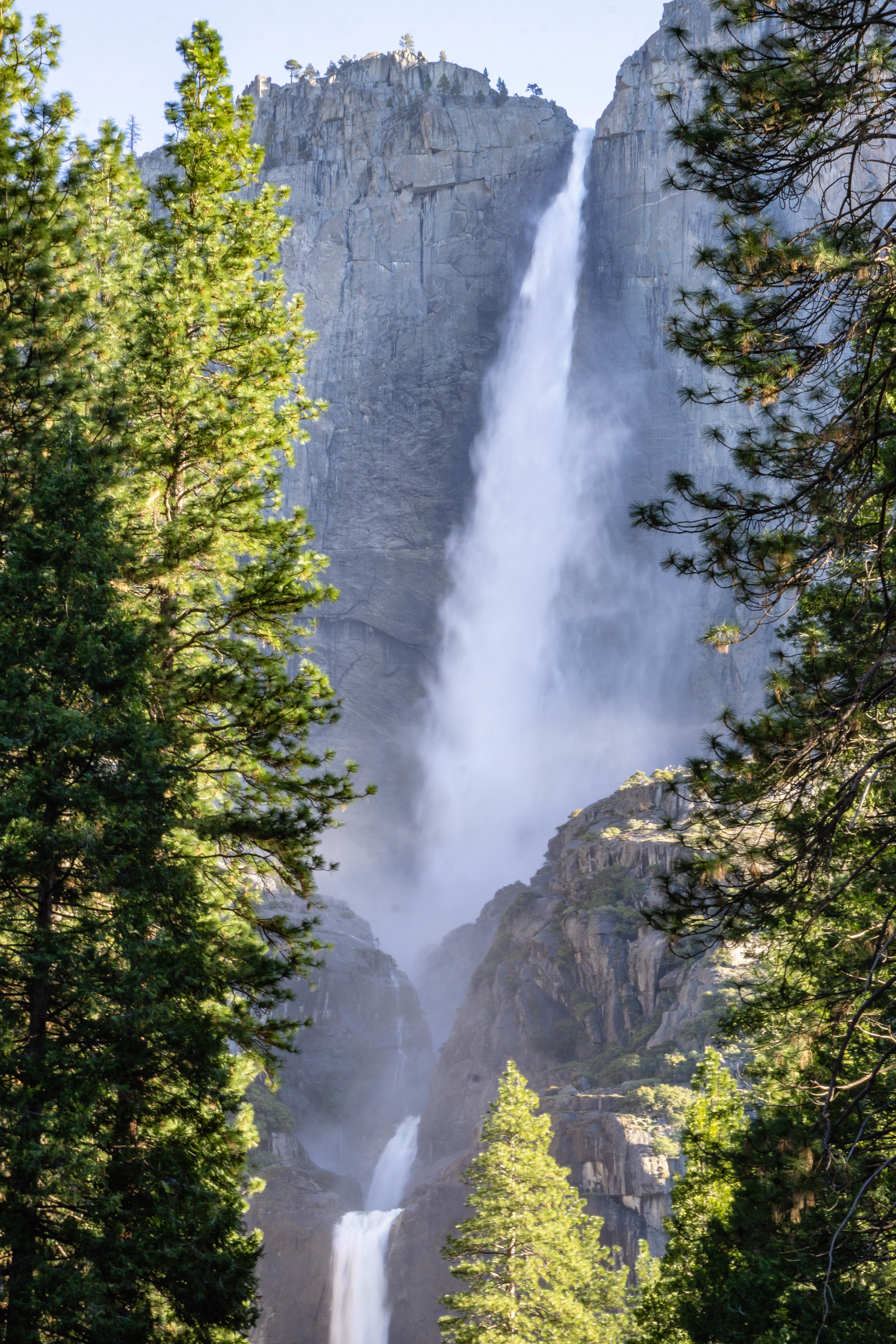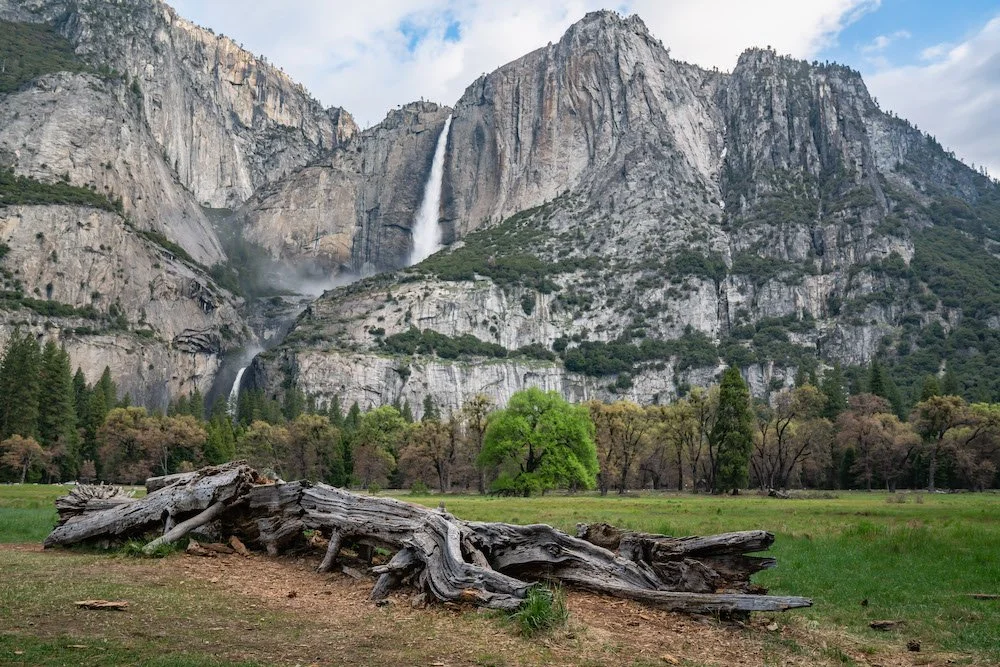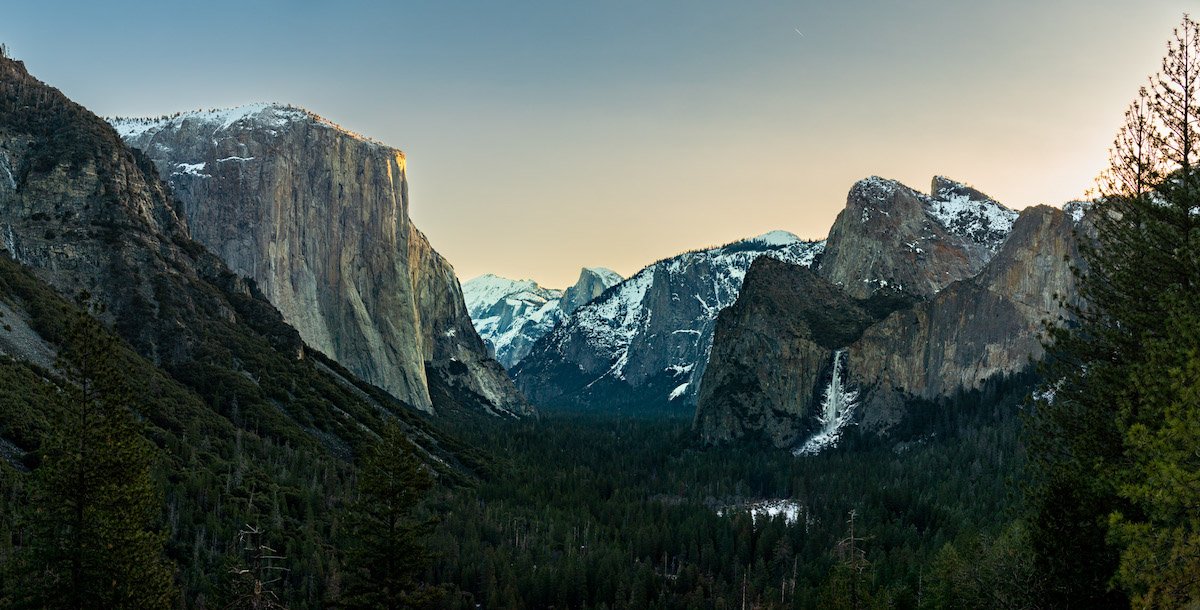How To Successfully Hike Upper Yosemite Falls
There are a lot of great reasons to hike to the top of Upper Yosemite Falls. The views from Yosemite Falls summit will take your breath away and the sound of the thundering flow humbles the soul. Halfway up the climb you get an amazing view of Yosemite Valley, with Half Dome in the distance. Once at the top, watch as the falls plummet down the side of the mountain and get a greater sense of just how far you hiked. And if you have the energy to continue onto Yosemite Point, your reward is one of the best views of Half Dome in all of Yosemite National Park.
This is not a hike to be underestimated. Getting to the top of Upper Yosemite Falls is challenging, most of the trail is a steady, uphill climb with a relentless number of switchbacks.
Pros
Breathtaking Scenery: Yosemite Falls offers some of the most stunning natural scenery in the world, with towering waterfalls, lush forests, and iconic rock formations like Half Dome.
Varied Trail Options: Yosemite offers a range of trail options for hikers of all levels, from easy strolls to challenging backcountry routes, ensuring there's a suitable hike for everyone.
Abundant Wildlife: The park is home to diverse wildlife, and you may encounter deer, black bears, and various bird species during your hike, providing unique opportunities for wildlife enthusiasts.
Photography Opportunities: The picturesque landscapes provide endless opportunities for photography, making it a paradise for nature and landscape photographers.
Educational Experience: Yosemite offers numerous interpretive programs and signs along the trails, allowing hikers to learn about the park's geology, history, and ecology as they hike.
Physical and Mental Health: Hiking in Yosemite not only offers physical exercise but also a chance to disconnect from the digital world, reducing stress and promoting mental well-being.
Cons
Crowds: Yosemite is a popular destination, and during peak season, trails can become crowded, detracting from the serenity of the experience.
Weather Variability: Yosemite's weather can be unpredictable, with sudden changes in temperature and the possibility of thunderstorms, which can be dangerous for hikers.
Limited Parking: Parking can be a challenge, especially during peak season, and hikers may need to rely on shuttle services, which can limit flexibility.
Wildlife Encounters: While encountering wildlife can be a pro, it can also pose risks if not handled responsibly. Bears, in particular, can be a concern, and proper food storage is crucial.
Trail Closures: Certain trails may be closed due to maintenance, weather conditions, or safety concerns, potentially limiting your hiking options.
Yosemite Falls Hike Overview
Yes, you can hike to all three waterfalls that make up Yosemite Falls. If you are trying to get to the top, this hike is called Upper Yosemite Falls Hike with the average time to hike to the top takes 5 hours and 35 minutes. Here are all the details on the Upper Yosemite Falls Hike:
Distance (round trip): 7.6 miles to the top of Yosemite Falls; 8.7 miles to Yosemite Point
Elevation gain: 3,218 feet; 3,700 feet to Yosemite Point
Route type: Out and Back
Trailhead: Camp 4
When to go: Spring, summer, or fall. The Yosemite Falls is at its maximum flow in spring and early summer. By the end of summer into autumn, it could be just a trickle or completely dry. During winter, this hike often has snow or ice, but if you want to go, check out this article I wrote on hiking Yosemite Falls during the winter.
Difficulty: Very strenuous
Most people only make the short trip to visit Lower Falls, but Upper Falls is definitely worthy of visiting due to its panoramic views of Yosemite Valley and the opportunity to see this amazing waterfall up close.
Step-by-step guide to enjoying Yosemite Falls Trail
Step 1: Preparation and Early Start
As the sun begins its ascent over the valley, we arise with a sense of anticipation. After grinding your own Verve coffee with a VSSL grinder and a hearty breakfast and packing our daypacks with essentials - water, snacks, a map, and sunscreen - we head to the trailhead. Arriving early not only ensures cooler temperatures but also offers the chance to secure a parking spot in the often crowded Yosemite Valley.
Step 2: Beginning the Ascent
The trailhead greets us with a signpost, and we embark on the first leg of our journey. The initial path is relatively flat, winding through a lush forest with the distant sound of the rushing creek as our companion. The scent of pine trees fills the air, and the early morning light dances through the leaves.
Step 3: Columbia Rock Vista
After about 1 mile, we reach Columbia Rock, our first reward. The vista here provides a captivating glimpse of Half Dome and the valley below. We pause to catch our breath and soak in the breathtaking panorama. Camera in hand, we capture the moment before continuing the ascent.
Step 4: Switchbacks and the Upper Falls Viewpoint
The trail becomes steeper, leading us through a series of switchbacks. As we ascend, the sound of the falls grows louder, teasing our senses. We approach the viewpoint for Upper Yosemite Falls, where the mist from the crashing water refreshes our faces. The view from here is awe-inspiring, as the falls plunge dramatically into the valley below.
Step 5: Lunch at the Yosemite Creek
Around the 2.5-mile mark, we find respite at Yosemite Creek. The cool, babbling creek is an ideal spot to enjoy a packed lunch. We refuel, dipping our feet into the icy water, while the melodious song of birds serenades us.
Step 6: The Final Push to the Summit
Feeling invigorated, we tackle the remaining portion of the trail. The landscape transforms as we ascend, with rugged terrain and wildflowers coloring the path. The rush of the falls serves as a constant companion, its crescendo beckoning us closer to the summit.
Step 7: The Grand Summit
After approximately 3.6 miles, we reach the grand finale – the summit of Yosemite Falls. As we stand at the overlook, we are humbled by the sheer beauty and power of the falls. The cascading waters plunge 2,425 feet, making it one of the tallest waterfalls in North America. The mist kisses our skin, and rainbows emerge in the spray, enchanting our senses.
Step 8: Moments of Reflection
We find a quiet spot to rest and reflect, surrounded by granite cliffs and the serenity of the high country. The vista offers unparalleled views of Half Dome, Sentinel Dome, and the surrounding wilderness, leaving us with a sense of achievement and wonder.
Step 9: The Descent
With the memory of the summit etched in our hearts, we reluctantly begin our descent. The return journey allows us to appreciate the trail from a different perspective, with the granite cliffs towering above and the valley unfolding below.
Step 10: Journey's End and Reflection
As we finally reach the trailhead, the golden hues of the setting sun greet us. The day's adventure has come to an end, but the memories and photographs serve as a testament to our remarkable journey to the top of Yosemite Falls. We leave with a deep appreciation for the natural beauty of Yosemite National Park and the invigorating feeling of conquering one of its most iconic trails.
Gearing Up to Day Hike Yosemite Falls
Preparing for a day hike to Yosemite Falls requires careful consideration of the gear and essentials you'll need to ensure a safe and enjoyable experience. Yosemite's rugged terrain and varying weather conditions make it crucial to be well-equipped. Here's a checklist to help you gear up effectively:
Clothing:
Layered Clothing: Yosemite's weather can change rapidly. Wear moisture-wicking base layers, insulating mid-layers, and a waterproof, breathable outer layer to adapt to temperature fluctuations and potential rain.
Best hiking shirt: BALEAF sun hoodie
Best hiking shorts: Wrangler authentic short
Best hiking pants: Wrangler ATC pants
Best hiking jacket: Columbia light puffy jacket
Hiking Boots: Sturdy, comfortable hiking boots with ankle support are essential for tackling uneven terrain and protecting your feet.
Best trail runners: Merrell Agility Peak 5
Best hiking boot: Timberland hiking boot
Best hiking shoe: Xero hiking shoe
Socks: Choose moisture-wicking, cushioned hiking socks to prevent blisters and maintain foot comfort during the hike.
Best thick sock: Carhartt Arctic
Best performance sock: Swiftwick Pursuit
Longest lasting sock: Darn Tough
Hat and Sunglasses: A wide-brimmed hat and sunglasses with UV protection shield you from the sun, while also reducing glare from snow or water.
Favorite hat: Sprints 5 panel hat
Best hiking sunglasses: Julbo Tahoe Aviators
Gear:
Daypack: Opt for a comfortable daypack to carry your essentials. Ensure it has adjustable straps and a hip belt for even weight distribution.
Best hiking backpack: Deuter Sprint
Best all around backpack: Big Agnes Impassable
Water Reservoir: Hydration is crucial. Carry a water reservoir or multiple water bottles to stay hydrated throughout the hike, especially during warmer months.
Also consider the bottle/filter combo like: Katadyn BeFree
Snacks: Pack energy-boosting snacks like trail mix, granola bars, and fruits to keep your energy levels up.
Map and Compass: Even if you're following established trails, it's wise to have a map and compass or a GPS device for navigation.
First Aid Kit: A basic first aid kit with bandages, antiseptic wipes, pain relievers, and blister treatment can be a lifesaver in emergencies.
Trekking Poles: Trekking poles can provide stability on steep descents and reduce strain on your knees.
Favorite trekking poles: Leki Khumbu
Binoculars: Wildlife enthusiasts may want binoculars to spot birds and animals.
Favorite binoculars: Anything by Nocs
Sunscreen and Lip Balm: Protect your skin from UV rays at higher altitudes, and prevent chapped lips with lip balm.
Favorite sunscreen: Dermatone Sport
Camera or Smartphone: Capture the stunning scenery, but don't forget to enjoy the moment too.
Favorite Beginner Camera: Sony A6400
Favorite Pro Camera: Sony A7r5
Favorite Lenses: Tamron Lenses
Headlamp or Flashlight: Be prepared for the possibility of hiking in low-light conditions. A headlamp or flashlight with extra batteries is essential.
Best headlamp: Nite Ize Rechargeable
Best flashlight: VSSL Flashlight
Seasonal Considerations:
Rain Gear: Pack a waterproof jacket and pants if hiking during the rainy season.
Best rain jacket: Arc’teryx Beta Rain Jacket
Best rain pant: Columbia Rain Pants
Winter Gear: If hiking in winter, add snow gear such as gaiters, crampons, and an ice axe for safety in icy conditions. But, let’s be honest, if you need an ice-axe you are no longer hiking!
Remember that your gear should be tailored to the specific conditions of your hike and the season. Prioritize safety and comfort to ensure an enjoyable day exploring the beauty of Yosemite Falls. Always check the weather forecast before your hike and consult park rangers for any additional recommendations based on current conditions. Happy hiking!
FAQ about Hiking Yosemite Falls
IS THE HIKE TO UPPER YOSEMITE FALLS HARD?
The hike to Upper Yosemite Falls is a strenuous hike that should be respected. With this said, please do not let the idea of a hard hike prevent you from going on this magnificent hike. There are several stopping points along the trail to enjoy the views of the falls. If at the that point the idea of the summit is too much, you can always turn around. Enjoy the hike, enjoy the views, and embrace your own challenge.
Read Next: How Hard is the Hike To Upper Yosemite Falls
How long of a hike is Upper Yosemite Falls?
The hike to Yosemite Falls can vary in length depending on the specific trail you choose to take and ranges from a half-day to a full-day of hiking. The most common route is the Yosemite Falls Trail, which is approximately 7.2 miles (11.6 kilometers) round trip to the Upper Yosemite Falls viewpoint. However, if you decide to continue to the top of Yosemite Falls, the hike becomes much longer, totaling around 13.6 miles (21.9 kilometers) round trip. The duration of the hike can also vary based on your fitness level and the time you spend enjoying the scenic viewpoints along the way, but expect to hike for the whole day if you go to Yosemite Point.
Read Next: Hiking To Upper Yosemite Falls
How Long does it take to hike lower yosemite falls?
The hike to the base of Lower Yosemite Fall is relatively short and easy, making it accessible to most visitors. The round-trip hike typically takes about 1 to 1.5 hours, including time to admire the waterfall and take in the scenery. The trail is approximately 1 mile (1.6 kilometers) in length and is mostly flat and paved, making it suitable for hikers of all skill levels. However, keep in mind that the trail can be crowded, especially during peak tourist seasons, which may affect the time it takes to complete the hike.
Is Yosemite Falls Hike Worth It?
The Yosemite Falls hike is considered by many to be absolutely worth it. It offers breathtaking views of one of the tallest waterfalls in North America and provides an opportunity to immerse yourself in Yosemite National Park's stunning natural beauty. However, whether it's worth it depends on your preferences and physical fitness.
The hike can be challenging due to its steep ascent and can be quite crowded during peak season. Yet, the awe-inspiring vistas and the sense of accomplishment make it a rewarding experience for many outdoor enthusiasts and nature lovers. Ultimately, if you enjoy hiking and appreciate magnificent scenery, the Yosemite Falls hike is likely to be worth your time and effort.
Read Next: Is Hiking Yosemite Falls is Actually Worth It
How Many drops does Yosemite Falls Have?
Yosemite Falls consists of three distinct drops:
Upper Yosemite Fall: This is the uppermost section of Yosemite Falls, with a single plunge of about 1,430 feet (435 meters). It's the tallest of the three drops and the one most visible from many viewpoints in Yosemite Valley.
Middle Cascades: Below the Upper Yosemite Fall, there are several smaller cascades and plunges collectively referred to as the Middle Cascades. While these are not as well-defined as the upper and lower sections, they contribute to the overall beauty of the waterfall.
Lower Yosemite Fall: The Lower Yosemite Fall is the final section and the most accessible. It has a drop of about 320 feet (98 meters) and is a popular destination for visitors. You can easily reach the base of the Lower Yosemite Fall via a short and paved trail.
Together, these three drops create the magnificent and iconic Yosemite Falls, one of the tallest waterfalls in North America.
What is the weather like at Yosemite Falls Each Season
Yosemite Falls, located in Yosemite National Park, experiences distinct weather conditions in each season. Here's an overview of the typical weather you can expect during each season:
Spring (March to May):
Spring is a transitional season in Yosemite Falls.
Temperatures start to warm up, but snowmelt from the winter can cause rivers and waterfalls, including Yosemite Falls, to be at their peak flow.
Expect daytime temperatures ranging from 50°F to 70°F (10°C to 21°C).
Be prepared for occasional rain showers, especially in April and May.
Trails may be wet and muddy due to snowmelt, so appropriate footwear is essential.
Summer (June to August):
Summer is the most popular season to visit Yosemite Falls.
Days are generally warm and dry, with temperatures between 70°F and 90°F (21°C to 32°C) in Yosemite Valley.
The waterfall flow decreases as the summer progresses, but the park's lush greenery and pleasant weather attract large crowds.
You can expect long daylight hours for hiking and exploring.
Make reservations for accommodations and campsites well in advance due to high demand.
Fall (September to November):
Fall brings cooler temperatures and changing foliage to Yosemite Falls.
Days remain comfortable, with temperatures ranging from 50°F to 80°F (10°C to 27°C) in Yosemite Valley.
Crowds begin to thin out, making it a quieter time to visit.
Fall colors are especially beautiful in October, with leaves turning vibrant shades of yellow and orange.
It's a great time for hiking and enjoying the scenery without the summer crowds.
Winter (December to February):
Winter in Yosemite Falls is characterized by cold temperatures and the potential for heavy snowfall.
Daytime temperatures can vary widely, ranging from 30°F to 50°F (-1°C to 10°C) in Yosemite Valley.
The waterfalls, including Yosemite Falls, may be partially or completely frozen, creating a stunning, icy landscape.
Some roads and trails may be closed due to snow and ice, limiting access to certain areas.
Winter is the least crowded season, providing a more peaceful and serene experience for those who don't mind the cold.
Keep in mind that Yosemite's weather can be somewhat unpredictable, so it's a good idea to check the park's official website or contact the park's visitor center for up-to-date weather conditions and any trail closures before your visit.
Yosemite Falls reflected in the Merced River. Photo by Dalton Johnson
Hiking Yosemite Falls is an experience that promises not just adventure but a deep connection to the heart of nature itself. This guide has illuminated the path, from understanding the trail's unique challenges to appreciating its awe-inspiring beauty. Whether you choose to take the shorter trek to the base of Lower Yosemite Fall or conquer the arduous climb to the summit, every step in this iconic national park is a testament to the enduring power and majesty of the natural world. As you lace up your hiking boots and set off on this remarkable adventure, remember to cherish each moment, respect the environment, and leave no trace so that this wondrous place may continue to inspire generations to come.












